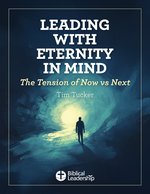Vision statements: How they are underused, overemphasized and mostly ineffective
 iStock
iStock
Every year, a handful of missional coach candidates shadow me on my consultations. Recently, we were discussing the use, misuse and impact of mission and vision statements.
Tim W.wrote: I did my graduate degree in business in the days when the competitive edge of Corporation, Inc. rested in mission statements and vision statements. The church world then adopted the language and approach.
My bias is still towards using these. I see them as critical pieces in organizational design—but I also do not want to spend copious amounts of time/energy/money generating these statements.
More to the point, if a congregation does have them, then they need to embed them deeply into the heart of the church. And, if they are not authentic and missionally driven statements, then it's pointless anyway.
Mark C.replied: I would agree on many of your points. The fact that it is what the local church "does" with their statements is what is important. In most cases these statements have been neglected in place of a Great Coffee Dream.
Tim W. replied to Mark: Hi all … As a denominational exec. I agree that churches can spend too much time on massaging vision and mission statement (if they even understand the difference/function of these two tools).
But I also think many churches spend too little time on them as well. There must be a balance. When properly formed and used, these statements provide a great deal of agenda harmony, synergy in the organizational system, clarity of priority in budgeting, effectiveness in staffing right and a host of other things.
Most importantly, it removes the fuzziness in the minds of the congregation as to congregational direction. In fact, when done well, the very process of drafting a statement together reveals gaps, relational deficiencies (both personal and organizational), and then creates energy, excitement, optimism and makes strategic planning more robust.
Of course, these statements in themselves can't do anything for the church; it's all in the way they are employed into the organizational system.The truth be told, though, most churches already operate from vision, but it's usually informal, imprecise and carried by a few power brokers in the church.
A couple of great questions to ask when conducting a first consult with the congregation is this: if your church was at its very best, what would this look like? Where would she spend her time and resources?
These questions do not directly address the vision question because if you ask "what is your vision?" most people will either recite what they read on the bulletin cover or will look dumbfounded. When asked outcome-oriented questions, however, a picture emerges.
I answered: Very good points everyone. I am not a big fan of vision statements (though I discuss them and the differences with mission statements in most of my books). I agree with everything said, that:
- vision statements help visualize a preferred future,
- create metrics for goal attainment,
- and get more people onboard that just the power-brokers.
But, I have seen them generate little use in these areas, despite pleas and pushing from the leaders.They often consume too much time, because I suspect, Christians like philosophizing and theologizing more than practicing something.
It helps seeing two styles of statements. Vision statements are tied to a project (think building program, launching a new ministry, church planting or church revitalization). They are sometimes needed, but they should be more flexible, temporal and more quickly created.
But mission statements are different. They deal with unchangeable values (and for Christians, our theology). They shouldn't change. But, the local church usually doesn't need to craft them, because the denomination or network has usually done that for them. So, I recommend.
- Have one mission statement that defines your theology, history and polity.
- Create multiple vision statements as time and projects dictate.
Bob Whitesel (D.Min., Ph.D.) is a foresight coach, professor, and award-winning author of 14 books. For over 30 years, he has guided leaders and churches to pivot and engage what’s next. He holds two earned doctorates from Fuller Theological Seminary and teaches on leadership foresight, church health, and organizational change. His website is www.ChurchForesight.com. Learn More » |
More on Vision & Culture
- Open borders or compassionate order? (by Bob Russell)
- They tried to quiet Charlie Kirk—but the gospel still speaks (by Bob Russell)
- What can Christian leaders learn from a 20-something YouTuber? Quite a lot… (by Zac McGowen)
- Steps to Launching Your Personal Workplace Ministry (by )


